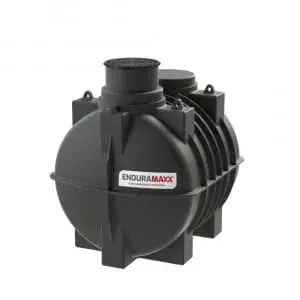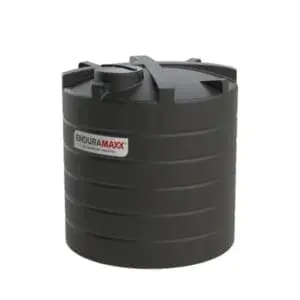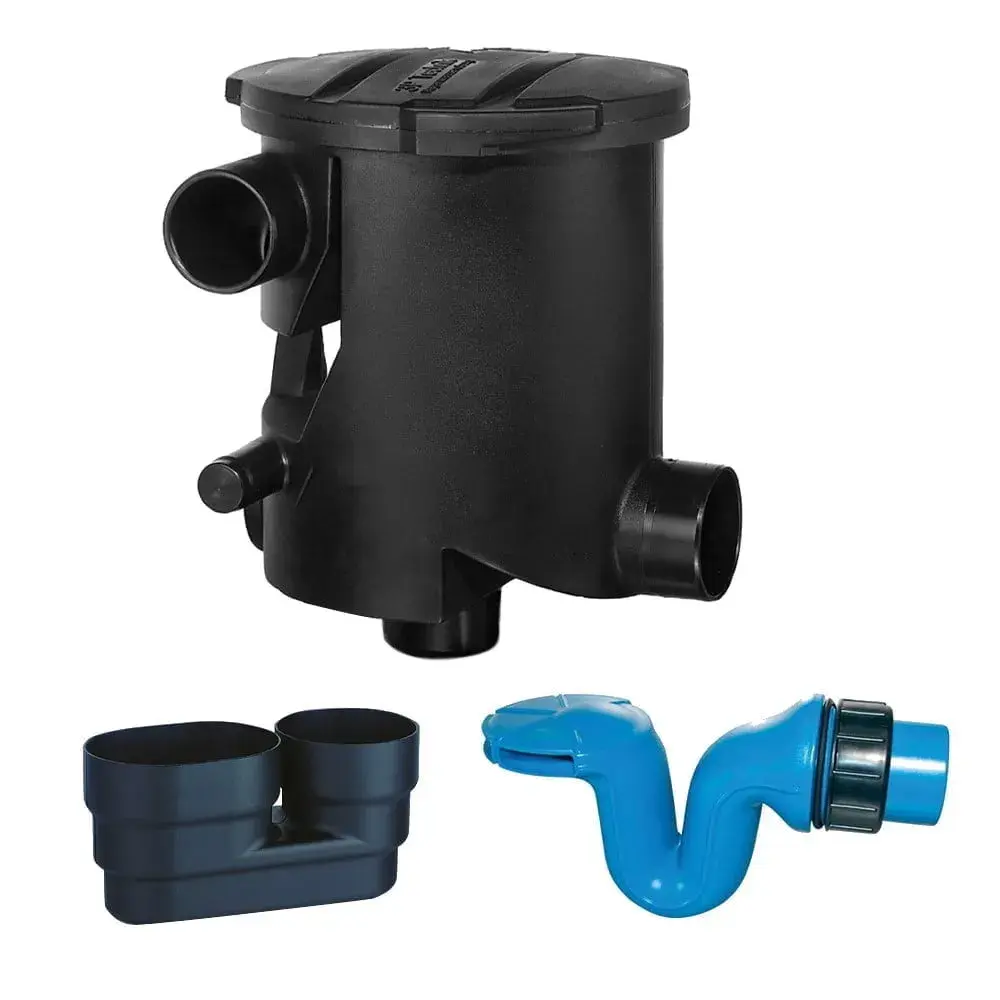Rainwater harvesting in three easy steps – knowing the best way to harvest rainwater is an excellent way to create a sustainable water supply for your home or business. Rainwater can be used in many ways from gardening to industrial use and reduces the amount of tap water you use. Collecting rainwater increasingly considered a viable and advantageous alternative to tap water with grants being available.
On a basic level harvesting rainwater is very simple and involves three stages: collection, transportation, and storage. There are a few things to consider at each of these stages which help to improve the effectiveness of your rainwater harvesting and ensure that your water is of the best possible quality.
Rainwater Collection Area
The first thing to decide is which surface to use to collect the falling rain and offer the best solution due to the large surface area. An important consideration here is how much rainwater can out collect and are the gutters in locations by which you can put a rainwater tank by.
Our rainwater collection chart below to see how much rainwater you could harvest.
How much rainwater can I collect?
To calculate the volume of rainwater you can collect use the following formulae: 1 mm of rain falling on 1 square meter will give 1 litre.
In the UK, the average rainfall each year is 800-1000mm, the following, the following table will give an estimate of how much rainwater you could save.
| Roof Area (Sq. Meters) | Annual Water Yield (Litres) |
| Greenhouse (5m2) | 5,000 |
| Garage (15m2) | 15,000 |
| 3 Bed Semi-Detached (70m2) | 70,000 |
| 3 Bed Bungalow (100m2) | 100,000 |
| 4 Bed Detached (100m2) | 100,000 |
For rainfall statistics for your location are available to view on the Met Office website.
Rainwater Guttering & Downpipes
Guttering and downpipes are used to transport rainwater from the roof to your rainwater harvesting tank. It’s best to prevent contaminants (leaves, moss, twigs etc) from entering the rainwater storage through the use of a rainwater filter. For installations for garden watering and agricultural sprayers, an inline suction filter is advisable to stop anything going which may have got into the rainwater tank into the sprayer or hose lines. A rainwater filter can be used to stop leaves entering the tank and an overflow is recommended for the tank when it’s full. These rainwater filters are spec’d for the area of the roof its collecting water for a small domestic house or shed to a large agricultural building.
Rainwater Storage
The points to consider at the final stage is the size of size and location of the water tank. Our rainwater harvesting tanks are available from 50 litres or 1000 litre slimline water tank for your garden to multiple tanks to get to over 100,000 litres for an agricultural, commercial or industrial site.
| 1,000 litre rainwater tanks | Small gardens |
| 1,000 – 2,000 litre rainwater tanks | Small-medium gardens |
| 3,000 litre rainwater tanks | Large garden |
| 4,000 litre rainwater tanks | Garden and basic utilities such as toilets/washing |
| 5,000-litre rainwater tank | Small house including utilities such as toilets/washing |
| 10,000-12,000 litre rainwater tank | Medium house including utilities such as toilets/washing |
| 15,000 – 20,000-litre rainwater tanks | Small to medium agricultural farm, commercial and industrial buildings |
| 20,000 – 50,000-litre rainwater tanks | Large scale agricultural farm, commercial and industrial buildings |
Where should I site my rainwater tanks?
Locating your rainwater tank requires consideration as to the best location and reducing the modifications needed to existing guttering. Placing your tank, along the water from guttering will incur extra costs running pipework to the tank. Rainwater tanks will require a concrete pad, flat in both directions, to the site the tank on – remember 1,000 litres will be 1 ton.
If electrical supplies are not close to the rainwater tank it is possible to gains some pressure by positioning it on higher ground so gravity can help to push water through the hosepipe. We supply regular water pump kits to pump water through a hosepipe or into other appliances, and mains water backup to ensure that your tank never runs out of water even in a drought.
Enduramaxx rainwater tanks are UV stabilised so can be in the sunlight without risk for the tank wrapping or fading however consideration to algae which can occur when the tank is placed in sunlight. A naturally cool or shaded spot and confined areas such as the side of buildings, alongside walls, are ideas for slimline water such as our 1000 litre slimline tank and 1500 litre round water tank.
Enduramaxx’s Rainwater Harvesting Collection Kits
Enduramaxx’s rainwater collection kits for domestic, agricultural, manufacturing and commercial water tanks including a water filter, calmed include and overflow. UV filtration and pumping equipment are generally specified to your requirements considering the flow and the final use of the water – pricing available upon request.
Step 1 Rainwater filter diverter
Rainwater falls from the roof via the guttering through the filter. Water flows through the screen and removing dirt and debris which is flushed to drain or soakaway.
Step 2 Calmed inlet
The diverted water runs down to the bottom of the tank and fills the tank through the claimed it from the bottom. This oxygenates the water in the tanks and helps prevents it from stagnating.
Step 3 Overflow siphon
When the tank is full the overflow siphon diverts the excess water to a drain or soakaway. The siphon design draws dust and pollen which may be on the water surface first.
Step 4 Submersible pump
A pump can be submerged in the tank or externally mounted at the bottom of the tank and be used for the desired requirement. Some additional UV treatment and filtration may be required depending on the use of washing machine/toilets to prevent discolouration.
More details are available on the video here.
For more details on Rainwater harvesting in three easy steps, please get in touch!
Posts By Topics
- Blog (303)
- Chemical Storage Tanks (118)
- Chemical Dosing Tanks (114)
- Chemical Tanks (114)
- Water Tanks (58)
- Rainwater Harvesting Tanks (43)
- Vertical Rainwater Tanks (31)
- Vertical Storage Tanks (31)
- Cone Bottom Tanks (19)
- Conical Cone Tanks (18)
- Rainwater Harvesting (17)
- Water Bowsers (15)
- Horizontal Tanks (14)
- Potable Water Tanks (13)
- Farming (9)
- Case Studies (8)
- Industrial Storage Tanks (7)
- Liquid Fertilser Storage Tanks (6)
- WRAS Approved Potable Tanks (6)
- Wine and Beer Production (6)
- Horizontal Transport Tanks (5)
- Microbrewery (5)
- Rainwater (5)
- Category 5 Break Tanks (4)
- Cider Production (4)
- Mixer Tanks (4)
- Molasses Tanks (4)
- Polyethylene tanks (4)
- Rainwater Filter Kits (4)
- SPECIALIST & BESPOKE TANKS (4)
- Bunded Tanks (3)
- Slimline Tanks (3)
- WRAS Approved (3)
- Clarification Tanks (2)
- Crosslinked Polymer Tanks (XLPE) (2)
- Fertiliser Tanks (2)
- Sump Tanks (2)
- Tank Installation (2)
- Water Butt (2)
- underground water tanks (2)
- ACCESSORIES & FITTINGS (1)
- ATV & UTV SPRAYING UNITS (1)
- Above Ground Effluent Tanks (1)
- Bespoke Tank Frames (1)
- Category 5 Turret (1)
- Caustic Soda Tanks (1)
- Closed Top Bunded Tanks (1)
- Craft beer (1)
- Effluent Tanks (1)
- Enduramaxx (1)
- Ferric Chloride Tanks (1)
- Fire Safety Regulations (1)
- Fire Sprinkler Water Storage Tanks (1)
- Industrial Water Tank (1)
- Open Top Bunded Tanks (1)
- Open Top Cone Tanks (1)
- Open Top Vertical Tanks (1)
- Polyethylene Potable Water Tanks (1)
- Polyvinylidene Fluoride (PVDF) Tanks (1)
- Polyvinylidene Fluoride Tanks (PVDF) (1)
- Pressure Washers (1)
- Pro Series Spot Sprayers (1)
- RWH (1)
- Sodium Hydroxide Storage Tanks (1)
- Sprayer Fill-up Tanks (1)
- Uncategorised (1)
- liquid fertiliser tank (1)
Sign up to the newsletter
enduramaxx.marketing
Related Posts
5 Reasons For Domestic Rainwater Harvesting | Enduramaxx
5 Reasons For Domestic Rainwater Harvesting – at some times of the year there’s uncertainty around...
Save Water With The Best Quality Rainwater Tanks Above & Below Tanks
Save Water with the Best Quality Rainwater Tanks, for those living on rural properties and running...
Water Quality in Rainwater Systems: Why Is It Important?
Water Quality in Rainwater Systems – the concept of collecting and using rainwater has been done...
Related Products
From £1,080.00 inc. VAT
£900.00 exc. VAT
From £1,344.00 inc. VAT
£1,120.00 exc. VAT
From £768.00 inc. VAT
£640.00 exc. VAT
£480.00 inc. VAT
£400.00 exc. VAT





